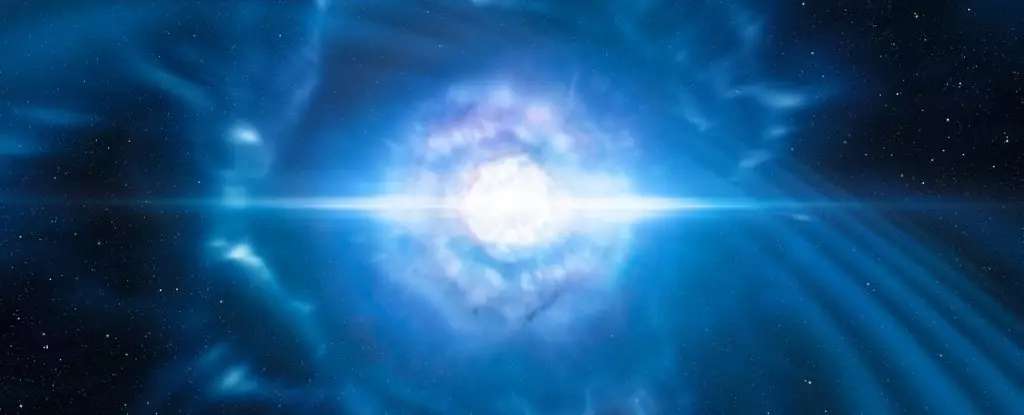In a groundbreaking astronomical event in August 2017, scientists from around the globe turned their telescopes towards the skies to witness a phenomenon that had only been theorized until that moment—a collision between two neutron stars. This extraordinary event, designated as AT2017gfo, provided rich data for scientific analysis and a deeper understanding of the cosmos. As the gravitational waves emitted by this cataclysmic merger rippled through space, they offered humanity invaluable insights into the mechanisms behind neutron star collisions and the subsequent aftermath that unfolds in a cosmic dance of energy and matter.
The aftermath of such a collision is far more than a momentary flash in the universe; it is a frenzy of atomic chaos that gives rise to heavier elements—those building blocks of matter that form the universe around us. Led by a team of researchers, including astrophysicist Albert Sneppen from the Niels Bohr Institute at the University of Copenhagen, studies of AT2017gfo have recently unveiled the intricacies of this intense astronomical explosion.
One of the core challenges faced by astronomers is the ephemeral nature of such events. Kilonovae, like AT2017gfo, evolve rapidly, presenting a moving target that is difficult for any single telescope to monitor. As the Earth turns, the visibility of these celestial phenomena shifts, complicating the collection of comprehensive data. However, the ingenuity of researchers has allowed them to piece together a detailed timeline of the explosion’s aftermath by integrating observations captured by diverse observatories located in Australia and South Africa, alongside the Hubble Space Telescope.
This multidisciplinary approach demonstrated a vital principle in scientific research: the whole can often reveal more than the sum of its parts. The amalgamation of data from different telescopes has allowed for a richer narrative surrounding the evolution of the kilonova, showcasing how such cosmic phenomena can serve as complex laboratories for understanding universal processes.
The Birth of Heavy Elements
A remarkable insight gained from the observation of AT2017gfo was the revelation that neutron star collisions forge a variety of heavy elements, challenging previous assumptions that only supernovae were capable of producing such materials. Stellar fusion typically ceases at iron, as it requires more energy to fuse heavier elements than what is produced by the fusion itself. However, the intense temperatures and pressures resulting from neutron star mergers create an environment ripe for nucleosynthesis.
Researchers observed the presence of heavy elements, particularly strontium and yttrium, within the emitted light of the kilonova explosion. This evidence not only confirmed kilonovae as significant contributors to the cosmic inventory of heavy elements but also indicated that these events may rival supernova explosions in their elemental fabrication capabilities. By meticulously analyzing the evolution of the kilonova over time, scientists gained insights into the rapid production of r-process elements, essential in constructing the framework of our universe.
The processes occurring during a kilonova bear striking similarities to the early stages of the universe, particularly during what astrophysicists refer to as the Epoch of Recombination. Around 380,000 years after the Big Bang, the universe cooled sufficiently for protons and electrons to combine, forming the first atoms and allowing light to permeate the cosmos for the first time. This monumental moment not only altered the evolution of the universe but also serves as a crucial event in the cosmic timeline.
In studying the kilonova aftermath, scientists have suggested that these explosive events could mirror the conditions of the early universe, providing potent analogs for understanding atomic formation and the cooling processes that followed the Big Bang. The observations confirm the emergence of atoms from their constituent particles within these distant explosions, making it possible to investigate the microphysics that govern such transformations.
The Promise of Future Research
The findings surrounding AT2017gfo spark excitement for the future of astrophysics. The ability to witness the birth of heavy elements and observe their trajectories within the context of cosmic phenomena offers a tantalizing glimpse into not only the mechanics of nucleosynthesis but also the continued evolution of our universe. These cosmic events serve as a reminder of the dynamic nature of the cosmos—where collisions happen on a grand scale, and the remnants of such events give birth to the elemental components that contribute to everything from stars to planets, and ultimately, life itself.
The study of neutron star collisions and their ensuing kilonovae stands as a testament to humanity’s enduring quest for knowledge. Each observation adds a grain of understanding to the vast cosmic canvas we inhabit, illuminating the processes that govern the evolution of the universe while tantalizingly hinting at the mysteries still left to be uncovered. As ongoing research continues to unfold, the insights derived from these celestial fireworks are likely to reshape our comprehension of the cosmos in profound ways.


Leave a Reply